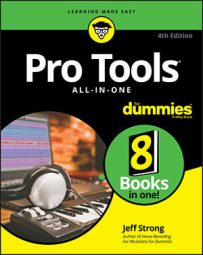Face it: As a home recordist, you’re unlikely to have easy access to the resources that create a top-notch sound room. Commercial studios spend serious cash — up to seven figures — to make their rooms sound, well, professional. However, you don’t need to spend near that amount of money (you mean you don’t want to sell off the private jet …?) to get great sounding recordings. All it takes is a little understanding of how sound travels, some ingenuity, and a little bit of work.
Sound isolation
One of the concerns that you (and your neighbors) are probably going to have when you start recording in your home is the amount of sound that gets in and out of your room. Sound waves are nasty little buggers. They get through almost any surface, and there’s not a lot you can do to stop it from happening.You’ve probably noticed this phenomenon when somebody with a massive subwoofer in his car drives by blasting some obnoxious music. (Ever notice how someone else’s music is obnoxious, whereas your music never is, no matter how loud you play it? Amazing …) Your windows rattle, your walls shake, and your favorite mug flies off the shelf and breaks into a thousand pieces. Well, this is one of the problems with sound: It’s physical energy.
The best (and classic) way to isolate your studio room from everything around it is to build a room within a room.
You can easily find resources to get you started by doing a Google search with the keywords “sound isolation.” Here are a couple of places to get you started:
- Sound Isolation Company: Aside from selling products to help you keep the sound in (or out) of your studio, you’ll find useful information here about the process of sound isolation.
- Netwell: Again, this company sells products to help control sound, but you’ll also find good basic information here to get you started.
Another idea is to try to choose a room in your house or apartment that is farthest away from outside noise (an interior room, for instance). Basements also work well because they’re underground and most of the sound gets absorbed by the ground. Installing a little fiberglass batting insulation in the ceiling — typical house insulation that you can find at your local home center — can isolate you pretty well from your neighbors’ ears. Detached garages are generally farther away from other buildings, so sound has a chance to dissipate before it reaches your neighbors (or before your neighbors’ noise reaches your garage).
Also keep these things in mind when trying to isolate your studio:
- Dead air and mass are your friends. The whole concept of a room within a room is to create mass and still air space so that the invading or escaping sound gets trapped. When you work on isolating your room, try to design in some space that can trap air (creating dead air) — such as a suspended ceiling or big upholstered furniture — or use double layers of drywall on your walls (mass).
- Don’t expect acoustical foam or carpet to reduce the noise. Using these can help reduce the amount of sound that bounces around inside the room but won’t do much to keep sound in (or out of) the room.
- Isolate the instrument instead of the room. Isolating the sound of your guitar amp can be much less expensive than trying to soundproof your whole room. Most commercial studios have one or more isolation booths for recording vocals and other acoustic instruments. You can use that concept to create your own mini isolation booths.
One idea for a truly mini isolation booth is to make an insulated box for your guitar (or bass) amp. If you just have to crank your amp to get the sound you want, you can place it inside an insulated box to reduce the amount of noise that escapes to the outside world.
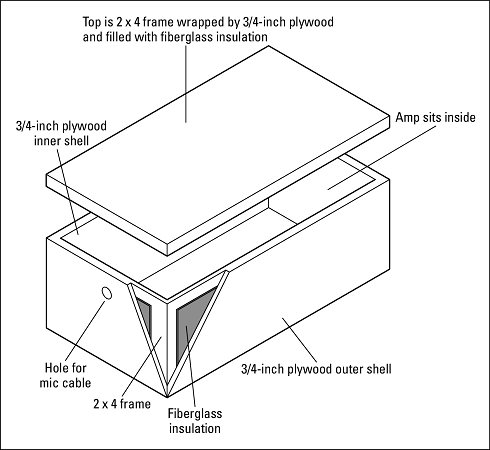 An amp-isolator box reduces the amount of noise you hear from your amp, even when it’s cranked.
An amp-isolator box reduces the amount of noise you hear from your amp, even when it’s cranked.
You can also create an isolated space in a closet by insulating it and closing the door when you record, or you can put your guitar amp (or drums) in another room and run a long cord from there to your recorder. If you do this, remember that for long cord runs, you need to use balanced cords. Otherwise you may get a bunch of noise, and your signal may be too low-level to record very well.
Sound control
After you create a room that’s as isolated from the outside world as possible, you need to deal with how sound acts within your room.Sound travels through the air in the form of waves. These waves bounce around the room and cause reflections (reverberations or echoes). One problem with most home studios is that they’re small. Compounding this, sound travels very fast — roughly 1,130 feet per second, depending on altitude, humidity and temperature).
When you sit at your monitors and listen, inevitably you hear the reflected sound as well as the original sound that comes from your speakers. In a big room, you can hear the original sound and reflections as separate sounds, meaning that the reflections themselves become less of a problem. For a good home studio, you have to tame these reflections so they don’t interfere with your ability to hear clearly what’s coming from the speakers.
How all these reflections bounce around your room can get pretty complicated. Read up on acoustics (how sound behaves) to discover more about different room modes: axial (one dimension), tangential (two dimensions), and oblique (three dimensions). Each relates to how sound waves interact while they bounce around a room. Knowing your room’s modes can help you come up with an acoustical treatment strategy, but there are very complicated formulas for figuring out your room’s modes, especially those dastardly tangential and oblique modes.
You can find out more on room modes, as well as discover some room mode calculators, on the Internet by using your favorite search engine and searching for “room modes.” Go to the website matches, and you’ll see quite a few places to start looking. Try researching these modes; this topic alone can fill an entire book.
The single best source for sound control and acoustics information is Ethan Winer’s forum at Musicplayer.com.
The two aspects of recording where sound control plays a major role — tracking and mixing — each require different approaches for you to get the best possible sound out of your recordings.Sound control during tracking
Tracking is what you’re doing when you’re actually recording. Two things that can make a room a bad environment for tracking are:- Not enough sound reflection
- Too much sound reflection
If your room is too dead (not enough sound reflection), you want to add some reflective surfaces to liven up things (the room, that is). On the other hand, if your room is too live (too much sound reflection), you need to add some absorptive materials to tame those reflections.
You can go out and buy a bunch of foam panels to catch the reflections, or maybe put in a wood floor or attach some paneling to the walls to add some life, but you’d be stuck with the room sounding only one way. It may end up sounding good for recording drums or acoustic guitar, but then it would probably be too live for getting a great vocal sound (which requires a deader space). One solution that worked well is to get (or make) some portable panels that can either absorb or reflect the sound.
The image below shows an absorber/reflector that works quite well. One side has an absorptive material (dense fiberglass insulation), and the other side has a reflective surface (wood). They are put together in an attractive frame and designed to stack easily when you want them out of the way. Even with very little woodworking experience, you can crank out a set of them in a weekend for very little money (about $50 per panel). If you make them (or hire someone to make them for you), you’ll find dozens of uses for them around your studio.
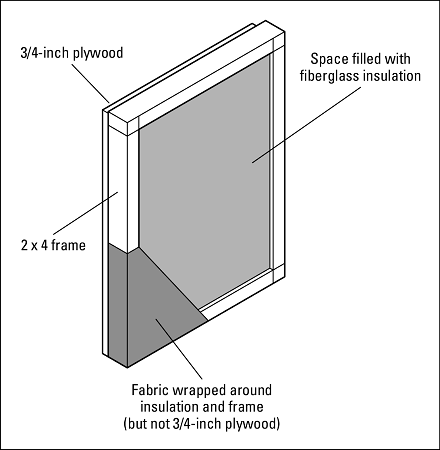 Portable absorbers/reflectors make changing the sound characteristics of your room quick and easy.
Portable absorbers/reflectors make changing the sound characteristics of your room quick and easy.
Sound control during mixing
Your first step in getting control of the sound of your (probably less-than-perfect) room during mixing is to get a good pair of near-field monitors. Near-field monitors are designed to be listened to up close (hence the “near” in their name) and will lessen the effects that the rest of the room has on your ability to hear them accurately and get a good mix.The next step to mixing in an imperfect room is to mix at low volumes. That takes the fun out of it, right? Well, as fun as it may be to mix at high volumes, it rarely translates into a great mix. Great mixing engineers often listen to their mixers at very low levels. Yes, they occasionallTuse high levels, but only after the mixing is pretty much done — and then only for very short periods of time. After all, if you damage your ears, you blow your career as a sound engineer. (Hey, that rhymes! Or is there an echo in here?) Try to resist the temptation to crank it up. Your ears last longer, and your mixes sound better.
Even with these two things (near-field monitors and low mixing levels), you still need to do something to your room to make it work better for you. The secret to a good mixing room is to tame the reflections of the sound coming out of your speakers.
Dealing with high and midrange frequencies is pretty easy — just put up some foam panels or the absorptive side of the panels. (See? I told you that you’d have a use for those panels.) Start by hanging two (or putting them on a stand or table) so they’re level with your speakers on the wall behind you. Also, put one on each sidewall right where the speakers are pointed. This positioning gets rid of the higher frequencies and eliminates much of the echo.
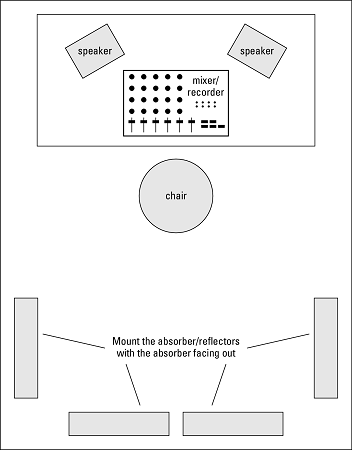 Positioning the absorber/reflectors like this helps with mixing.
Positioning the absorber/reflectors like this helps with mixing.
You may also need to put something on your ceiling right above your head, especially if you have a low (8 feet or less) or textured ceiling. (You know, one with that popcorny stuff sprayed on.) You may not want to mount one of the absorption panels over your head because they’re fairly heavy. Wrapping up a couple of 2-x-4-foot panels made of dense fiberglass (the same ones used in the absorber/reflectors) in fabric would work just about perfectly.
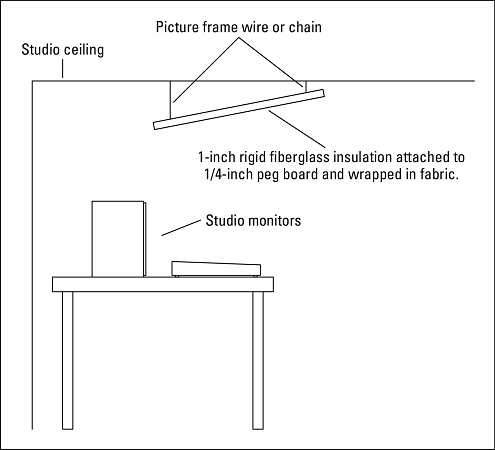 Use overhead panels to get rid of reflections off the ceiling.
Use overhead panels to get rid of reflections off the ceiling.You can also place a set of these overhead panels in the corners of your room behind the speakers. Just hang them at the same height of your speakers so that they cut off the corner of the room. If there isn’t enough room to fit the panels at an angle in the corner, you can eliminate the backing from the fiberglass and bend the fabric-covered panel to fit right in the corner. Either approach will absorb sound that may otherwise bounce around behind the speakers.
Another thing that you need to consider when you’re mixing is standing waves, which are created when bass tones begin reflecting around your room and bounce into each other. Standing waves have a weird effect on mix quality. They can either overemphasize the bass from your speakers (resulting in mixes that are short on bass) or cancel out some — or all — of the bass coming out of your speakers (resulting in mixes with too much bass). One of the problems with standing waves is that they can really mess up your mixes, and you may not even be aware that they are there.
To find out whether you have a problem with standing waves in your studio, sit in front of your monitors and put on one of your favorite CDs. Now listen carefully. Okay, now lean forward and backward a little bit. Does the amount of bass that you hear change as you move? Next, get up and walk around the room. Listen for places within the room where the bass seems to be louder or softer. You may find places where the bass drops out almost completely. If either inspection gives you a variable experience of the bass, you are the proud owner of standing waves. Don’t worry, though. You can tame that standing-wave monster with a pair of bass traps.
Bass traps absorb the energy in the lower frequencies so they don’t bounce all over your room and throw off your mixes. You can buy bass traps made of foam from some music stores, or (yep, you guessed it) you can make your own out of wood and insulation.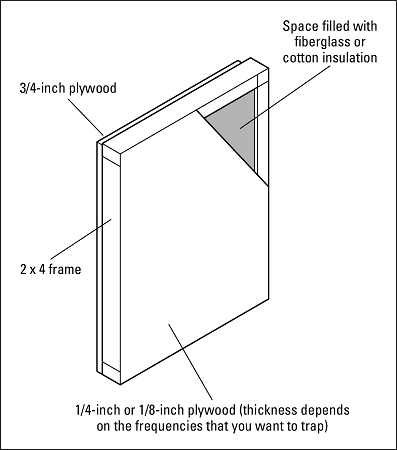 Use bass traps to get rid of standing waves.
Use bass traps to get rid of standing waves.
The most common placement for bass traps is in the corners behind you when you’re sitting at your mixer. You may also find that putting a set in the other corners of the room helps even more.
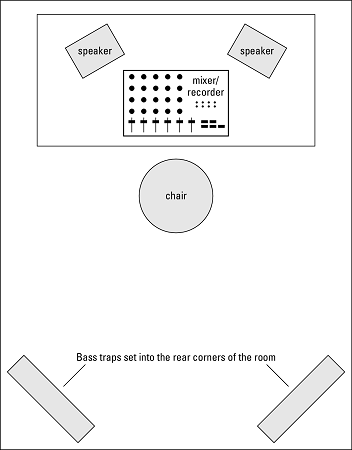 Put bass traps in the corners behind you to eliminate standing waves.
Put bass traps in the corners behind you to eliminate standing waves.
After you place the bass traps, do the listening test again. If you notice some areas where the bass seems to get louder or softer, try moving the bass traps around a little. With some trial and error, you’ll most likely find a place where they seem to work best.
Try not to get stressed out about the sound of your room. As important as your room’s sound may be, it has a lot less effect on the quality of your recordings than good, solid engineering practices. Do what you can, and then work with what you’ve got.

